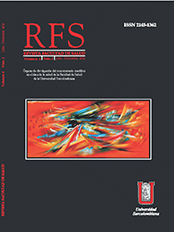Adverse reactions associated to antipsychotics use at the mental health unit of University Hospital in Neiva
##plugins.themes.bootstrap3.article.main##
Psychiatric disorders are diseases that occur frequently in the world. In Colombia is estimated that 40% of the population may suffer from any of these, which will lead to increasing the use of antipsychotic drugs with its adverse reactions. In order to identify adverse reactions related to the administration of antipsychotic medications in patients hospitalized at the Mental Health Unit of University Hospital in Neiva, it was performed an observational, descriptive and cross-sectional study of pharmacovigilance from February 8 to April 8, 2012. Twenty two (18%) out of 118 patients hospitalized at the Mental Health Unit, had a reaction to antipsychotic medication, documenting a total of 39 cases (33%) of adverse reactions, since some patients had more than one reaction. Haloperidol was the most common administered drug by 89.7% of cases, being the intramuscular route the most frequent one (83%), a dose of 5 mg (79.3%), showing 72.4% of adverse reactions during the first 3 days of administration. 77% of all cases of adverse reactions to drugs (ARDs) secondary to administration of antipsychotics correspond to the so-called extrapyramidal syndrome from which dystonia appeared by 49% of cases, mainly on face by 53% of cases, followed by sialorrhea by 10.3%. Implementation of strategies for monitoring and timely detection of ADRs in patients receiving antipsychotics, mainly intramuscular haloperidol could result in reduction of these and subsequent major complications.
Downloads
##plugins.themes.bootstrap3.article.details##
Organización Panamericana de la Salud. Tratamiento farmacológico de los trastornos mentales en la atención primaria de salud. Washington, D.C.: OPS, 2010. ISBN: 978-92-75-33113-2.
Posada JA, Trevisi C. Prevalencia de trastornos mentales y uso de servicios: Estudio Nacional de Salud Mental. Colombia, 2003. Rev. Colomb Psiquiatr 2004;33(5):241-262.
Nieto R, Silva H. Prescripción de antipsicóticos atípicos en pacientes hospitalizados de la Clínica Psiquiátrica Universitaria. Rev. chil. neuro-psiquiatr, Santiago, marzo 2008; 46(1).
Kurz M, Hummer M. Extrapyramidal side effects of clozapine and haloperidol. Psychopharmacology. March I 1995;118(1):52-56.
Cardeso A, Jiménez López G, Alfonso Orta X, Avila Pérez J. Taller Nacional Farmacéutico de Servicios Hospitalarios (2009: Ciudad de la Habana), Caracterización de reacciones adversas por antipsicóticos clásicos en ancianos. Instituto de Farmacia y alimentos, Universidad de la Habana, Cuba 2003-2008.
Campo-Arias A, Cassiani Miranda C. Trastornos mentales más frecuentes: prevalencia y algunos factores sociodemográficos asociados. Rev. Colomb. Psiquiat 2008;37(4):1-4.
Markowitz JS, Brown CS, Moore TR. Atypical antipsychotics. Part I: Pharmacology, pharmacokinetics, and efficacy. Ann. Pharmacother 1999;33:73-85.
World Health Organization, The Uppsala Monitoring Centre. The Importance of Pharmacovigilance. Uppsala: World Health Organization, The Uppsala Monitoring Centre, 2002.
Bateman DN, Rawlins MD, Simpson JM. Extrapyramidal reactions to prochlorperazine and haloperidol in the united-kingdom. Quarterly Journal of Medicine. Volume: 59 Issue: 230, pp. 549-5.
Rummel C, Hamann J, Kissling W, Leucht S. New generation antipsychotics for first episode schizophrenia. Base de datos de Cochrane de revisiones sistemáticas, 2003, Issue 4. Art. No.:CD004410. DOI: 10.1002/14651858.CD004410.
Khanna R, Arunava D. y Damodaran SS. Prospective study of neuroleptic-induced dystonia in mania and schizophrenia. Am J Psychiatry 1992;149: 511-513.
Bass Robert R, Vargas Jonathan. En: Haddad Jester m, Winchester James F. The antipsychotic drugs. Philadelphia: W.B. Saunders. 1990;780-793.
Richelson E. Neuroleptic affinities for human brain receptors and their use in predicting adverse effects. J Clin Psychiatry 1984;45:331-337.
Baker PB. Merigian KS, Roberts JR. Hyperthermia, hypotension, hypertonia and coma in a masive thioridazine overdose. Am J Emerg Med 1988;6:346-349.
Ray W, Chung C, Murray K, Hall K, Stein M. Atypical Antipsychotic Drugs and the Risk of Sudden Cardiac Death. N Engl J Med 2009;360:225-235.
Lykouras L, Markianos M, Hatzimanolis J, Oulis P, Christodoulou GN. Prolactin secretion in response to haloperidol challenge in delusional (psychotic) and non-delusional depression. Eur Psychiatry 2000;15:480-482.
Laverde L A. Síndrome neuroléptico maligno. Revista Facultad de Salud 2010;2(1):85-90.
Tomado de online:http://www.hospitaluniversitarioneiva.com.co/dotnetnuke/Servicios/UnidaddeSaludMental/tabid/69/language/es-CO/Default.asp
Naranjo C, Busto U, Sellers E, Sandor P, Ruiz I, Roberts E, et al. A method for estimating the probability of adverse drug reactions. Clin Pharmacol Ther 1981;30:239-245.
Ceruelo J, García S. Antipsicóticos típicos. Antipsicóticos atípicos. Form Med Contin Aten Prim. 2007;14:637-47; 14(10).
Gaebel A. Side effects of atypical antipsychotics: a brief overview. World Psychiatry. February 2008;7(1):58-62.
Miller LG, Jankovic J. Neurologic approach to drug-induced movement disorders: a study of 125 patients. South Med J. May 1990;83(5):525-532.
Muench J, Hamer A. Adverse Effects of Antipsychotic Medications. Am Fam Physician. 2010;81(5):617-622.
San Miguel Zamora Ma, Vila Clérigues M. Incidencia de efectos extrapiramidales en pacientes con esquizofrenia tratados con haloperidol solo o asociado a biperideno. Farm Hosp 1995;19(4):225-228.
OTRAS FUENTES
Goodman & Gillman. 2006. Las Bases Farmacológicas de la Terapéutica. 11º Ed. Mcgraw-Hill Interamericana. México.
Goodman & Gillman. 2009. Manual de farmacología y terapéutica. 1º Ed. Mcgraw-Hill Interamericana. México.
Katzung BG. Farmacología Básica y Clínica. 2009. 11º Ed. Mcgraw-Hill Interamericana.México.
Malgor LA, Valsecia ME. 2001. Farmacología Médica. Volumen 5. Farmacología del SNC y Psicofármacos. Benzodiazepinas y Neurolépticos, Anticonvulsivantes, Antiparkinsonianos, Antidepresivos, Droga Dependencia, Farmacología Clínica. España.










